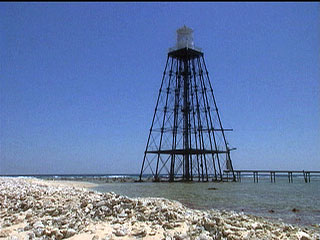 |
TO
~RON'S WORLD12~
I've had the good fortune to visit the following 3 Lighthouses. If your in the area the trip is truly worth while.
 |
~Cape Canaveral Lighthouse~
~Florida~
A Brief History
| In 1848, local officials erected the first lighthouse on the Cape. The 60-foot structure proved to be so ineffective, by the time ships were close enough to see the light, they were often already upon the very shoals they were trying to avoid.
In 1860, approval to build a 145-foot cast iron tower was given by the Lighthouse Board. Construction was unfortunately halted by the onset of the Civil War. The original tower, along with all other southern lights, was darkened for the duration of the war, by order of the Confederate Secretary of the Navy. After the war, construction of the new tower resumed, although somewhat slowly. On May 10th, 1868, the new station finally exhibited its powerful, first order Fresnel lens. With a focal plane of 137 feet, mariners could spot the beacon for more than 18 nautical miles. Beach erosion so seriously threatened the tower, by 1883, only 192-feet separated the lighthouse from crashing waves. Attempts to fight the encroaching ocean with jetties proved futile. Between 1893 and 1894, the Lighthouse Board dismantled the iron and brick tower and re-erected it 1.25 miles inland. Today it is automated and stands on the grounds of the Kennedy Space Center.
~Sand Key Lighthouse~ |
 |
~Cape Florida Light~
~Key Biscayne~
A Brief History
Cape Florida Lighthouse was first built in 1825 at a cost of $24,000. The brick tower was 65 feet tall. The lighthouse generated many complaints in its early years, with most of the blame centered on the light's first keeper, John Dubose. At one point, Dubose admitted to living in a house on the mainland 5 miles away while his black slave, a woman, kept the lighthouse. After being reprimanded, Dubose returned to the lighthouse.
The area around present day Miami was abandoned in mid 1835 when Seminole Indians massacred the wife and children of William Cooley near present day Fort Lauderdale. The refugees gathered at the Cape Florida Lighthouse for protection before fleeing the area entirely for Key West. Two days later, William Cooley volunteered to return to the lighthouse to restore the light. Dubose finally returned to the lighthouse a few months later.
In July 1835, there were three guards posted at the lighthouse to assist Dubose. Desiring to sail to Key West for supplies, Dubose and one of the men sailed away, leaving John Thompson and Aaron Carter (an elderly black man who was probably a slave) to keep the light.
On the afternoon of July 23, 1836 the lighthouse was attacked by a large group of Seminole Indians. After a drawn out gun battle, the Indians set fire to the wooden door of the lighthouse, forcing Thompson and Carter up to the top of the lighthouse. Forced outside onto the ledge of the lighthouse by the heat and smoke, Carter was killed and Thompson wounded several times in the feet. In an act of desperation, Thompson flung a keg of gunpowder onto the stairs of the lighthouse, hoping to kill himself to avoid further suffering. The blast destroyed the lighthouse's interior wooden stairway, keeping the fire from further injuring Thompson. Thompson feigned death, and the Indians later withdrew.
Thompson was rescued the next day by the crew of a U.S. Navy schooner. To get Thompson down, the sailors fired a ramrod with a piece of string tied to it over the top of the lighthouse. Thompson caught the string and was able to haul a heavier rope to the tower's top. Two seaman hoisted to the top hauled the injured Thompson down. It was later reported that the top of the lighthouse had more than 200 bullet holes in it.
Funds of a new lighthouse were appropriated in 1837, but the continued threat of Indian attacks prevented construction of a new tower until 1846. With continuing complaints about the quality of the light, it's height was increased to 95 feet in 1855. At the same time, a 2nd order Fresnel lens was installed.
The lighthouse suffered again during the Civil War when the center portion of the lens was smashed by three confederate sympathizers on the night of August 21, 1861. The light wasn't relit until 1867.
The lighthouse was discontinued on June 15, 1878 when nearby Fowey Rocks Light was first lit. The tower and property were sold to various private owners the keepers' dwelling eventually washed away.
In the late 1960's the area was slated for development. The state of Florida saved the lighthouse by establishing Bill Baggs Cape Florida State Park.
The state restored the lighthouse and keeper's dwelling. On June 15, 1978, 100 years after it was extinguished, the U.S. Coast Guard reestablished the light using a glass 375 mm lens.
The condition of the tower deteriorated in the early 1990's to the point were scheduled tours were canceled. Hurricane Andrew on Aug 24, 1992 uprooted most of the trees on the point, but the lighthouse and dwelling survived with only moderate damage.

Thanks so much for stopping by. I truly hope you enjoyed the visit.
Please sign my Guestbook. Your comments would be "Appreciated".
 Sign My Guestbook
Sign My GuestbookReceived 11-27-01
Thanks Darlene  Your an Angel.
Your an Angel.
Received 11-29-01
Thanks Barb's  God Bless.
God Bless.

Received 12-19-01

Received 01-15-02
HOME

 for her Graphics...
for her Graphics...